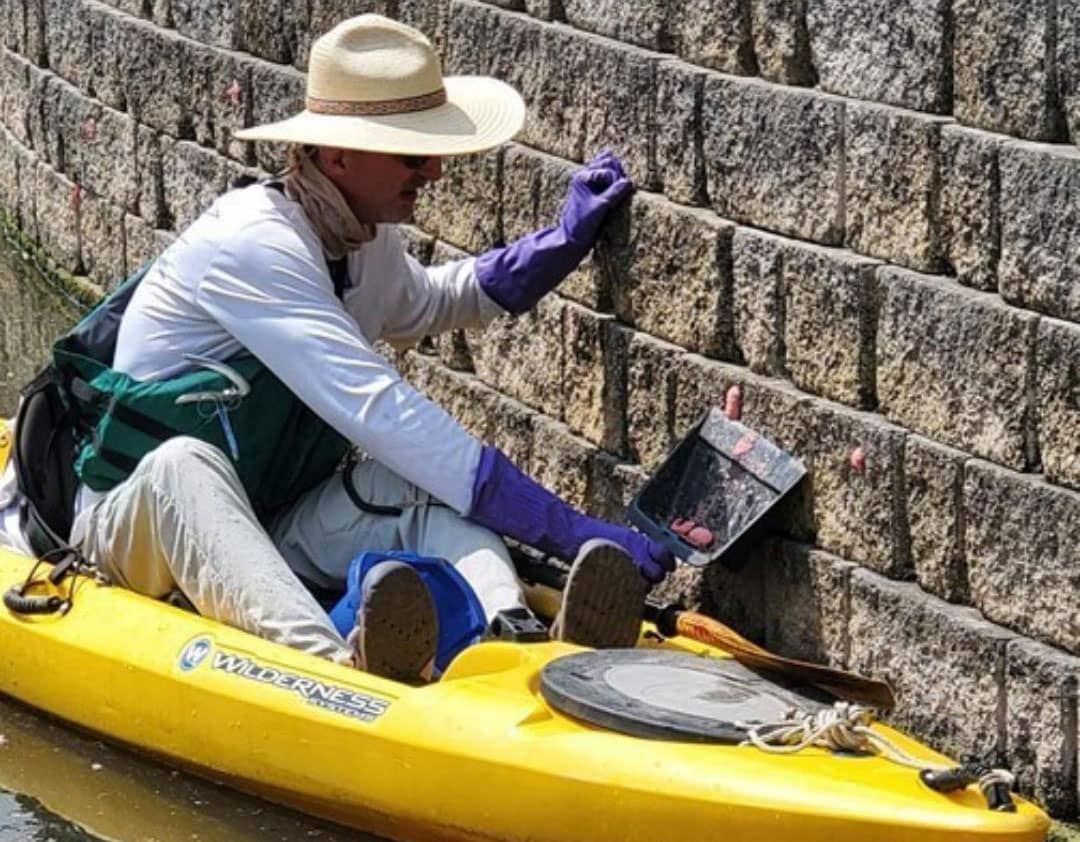Introduction & Important Notes:
The San Antonio River Authority (SARA) stresses that you should be trained / certified by attending their training before removing apple snails that you may find yourself. These trainings are offered through their volunteer program River Warriors.
The River Warrior program is free to join and it allows you to volunteer in projects like river clean-ups, maintaining native habitats, and invasive species removal – like removing apple snails!
More information on the program is available on SARA’s website but the main requirements are that you be at least 15 years old and sign a liability waiver.

Apple Snail Identification
Snails
- Apple snails (Pomacea maculata) can grow to up to six inches high—about the size of a baseball or human fist—although a size of approximately 1.5 inches is more common.
- Distinctive spiral shell and banding patterns throughout the shell whorls.
- The shell opening or aperture is large and oval or round and covered by a bony operculum with concentric rings that can be retracted into the aperture.
- Shell color varies from yellow to brownish-black with or without dark spiral bands.
- Their presence is often first detected by observation of their bright pink egg masses, which are laid just above the water line on emergent vegetation, woody debris, and manmade structures.
- Remnants of these egg masses can remain long after the snails have hatched and fade to nearly white over time.
Egg Masses
Apple Snail Removal / Dispatching
Snails
It is against the law to handle adult snails without a permit.
Although, once you get River Warrior training directly through SARA, you can then catch and dispatch any snails you may find.
Dispatching is done by first placing the snail in a black bag (we use the dog waste bags found all along the river). You can then tie the bag and simply throw it away, you can also crack the shell on the pavement and then throw them away in regular trash bins.
Egg Masses
You can dispose of the egg cases, without a permit.
Egg masses are usually found against concrete walls and can be removed with a flat object like a putty knife or dust pan.
Dispatching of eggs is also done by placing the eggs in a black bag, seal by tieing and disposing of the bag in the trash.
Make sure to wear gloves when removing/dispatching snails or egg masses.
If you are not trained by SARA or can not reach snails or egg casings you can report any sighting of egg cases or adult snails by calling toll-free at (866) 345-7272 or through SARA’s website.
How did Apple Snails get here?
SARA Biologists believe they were introduced to the river by an aquarium dump.
This is why it is important to not release any store-bought critters into the natural area. Usually aquarium species and pet store animals are not native to the area, so while releasing them may seem like the right thing to do, you may be introducing the habitat to an invasive non-native species.
Why are apple snails bad?
Giant Applesnails (Pomacea maculata) are native to South America and highly destructive invasive species throughout Texas. As such, they are on the Texas Parks and Wildlife (TPWD) Invasive, Prohibited, and Exotic Species list.
These snails have no known predators in the San Antonio River basin.
Because nothing eats them, biologists say they are free to reproduce at will, and take over territory and resources that rightfully belong to native species.
While the egg sacks begin their life journey above the water line, the mature animals live in the water and biologists say they can grow to be the size of an apple, eating their way through native vegetation and damaging the river bed and banks with burrowing behavior.
If the snails are eating aquatic vegetation, it’s no longer available for refuge or for larger fish to use as spawning habitat, with no shelter or places to spawn, this can hurt the fish population.
Apple Snails curernt location in the River
Apple snails like slow-moving water and the downtown area is their perfect habitat. The snails also like laying their eggs on the concrete river walls.
So far the snails seem to be found only from the Pearl brewery area of the river down to the King William / Southtown portion of the river.
SARA biologists say that while the snails have not yet been found further down the river, in the Mission Reach area, for example, we should still keep an eye out just in case they turn up, but that it is not their ideal habitat since the water is more fast-moving.
SARA also advises that snails or egg casings can not be collected from the river walk area directly downtown where shops and food are located. You are also prohibited from getting in the water other than by kayak or canoe (no swimming or wading).

